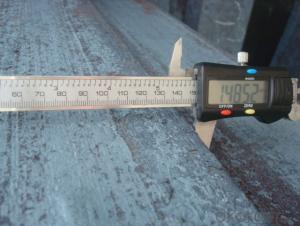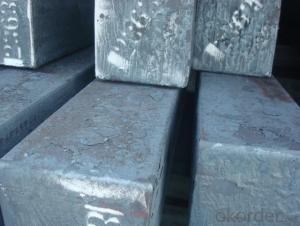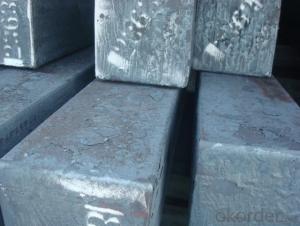Continue Casting Steel Billet Made by Blasting Furnace
- Loading Port:
- Tianjin
- Payment Terms:
- TT OR LC
- Min Order Qty:
- 1000 m.t.
- Supply Capability:
- 100000 m.t./month
OKorder Service Pledge
OKorder Financial Service
You Might Also Like
Continue Casting Steel Billet Made by Blasting Furnace
1.Structure of Continue Casting Steel Billet Made by Blasting Furnace
Continue Casting Steel Bloom Manufactured by Blasting Furnace is the raw material of all kinds of steel mill. Billet section of square, round, flat, rectangular and abnormity, etc Several, mainly related to shape of rolled products. Simple rolled section steel, choose cross section of square billet or rectangular billet. rolling The sector products such as flat steel, Angle steel, select the rectangular billet or slab. Had better profiled billet when production beams, channels, and in rolling process Lines and improve the yield. The raw material of round billet is the production of seamless tube.
2.Main Features of Continue Casting Steel Billet Made by Blasting Furnace
Continue Casting Steel Bloom Manufactured by Blasting Furnace section size should meet the requirements of rolling deformation and finished product quality, but also roll strength and biting condition of restrictions. General steel Billet section height H. And the roll diameter D The ratio of the ( namely H/D) Should be less than or equal to zero 0.5 . Length of steel billet by finishing temperature, Rolling time and the length of the product Or times ruler. When heated too long accident prone to bump the furnace wall of steel, too short, furnace bottom utilization rate is not high, influence the heating furnace production. For the production Choose a variety of steel and steel billet, should consider the affinities of billet, as far as possible in order to improve the productivity of the roughing mill, simplify the stock management of workshop.
3. Continue Casting Steel Billet Made by Blasting Furnace Images


4. Continue Casting Steel Billet Made by Blasting Furnace Specification
1)SIZE
2)MATERIAL GRADE
3)CHEMICAL ELEMENTS COMPOSITONS
Material standard The editor Range of thickness: 150-240 - mm + / - 5 mm width range: 880-1530 - mm + / - 20 mm Length: 3700-10000 - mm + / - 500 - mm Cross-sectional size: 64 * 64; 82 * 82; 98 * 98; 124 * 124; 120 * 150; 152 * 164; 152 * 170 mm Length: 9000 mm Section of tolerance: billet: 1.0 + / - 2.0-1.0 + / - 1.0 mm slab: width: + / - 2.0 mm thickness: + / - 3.0 mm The length tolerance: + / - 200 mm Section diagonal tolerance: 3.5-8.0 MM Billet section size protrusions requirements: < 1242 mm, do not allow; > = 1242 mm, < = 2 mm 1242 mm, < = 3 mm Beheading (shear) extension deformation: < 1242 mm billet: no control; The slab: < = 15 mm Surface tilt: no more than billet section 0.1 Bending: every 1 m length is not more than 10 mm The distortion: length < = 5 m, < = 11. ; The length of the < = 7.5 M, < = 5. Material % 3 sp/PS chemical composition: C Mn Si S P
The classification of the steel According to the quality classification (1)Ordinary steel (P 0.045% or less,S 0.050% or less)POn behalf ofphosphorus,s.On behalf ofsulfur Pands.Are all of the steelThe harmful elements, a leading toHot brittleness, a leading toCold brittle (2)High quality steel (P,s.both0.035% or less) (3)High quality steel (P 0.035% or less,S 0.030% or less
5.FAQ of Continue Casting Steel Billet Made by Blasting Furnace
We have organized several common questions for our clients,may help you sincerely:
①How to make diffirence of the grades?
You can do the chemical composition of the products by some lab.for example send the samples to SGS inspeciting company.
②If we want to get the shortest production term, which spec. is more easy to produce?
150*150*12000MM, Q235.
③Which steel mill is the best quality?
In China, if the national steel mill's quality is very good and stable, or private steel mill, you have to make sure the furnace is blast furnace and the quantity every day is big enough.
- Q: What is the role of steel billets in the manufacturing of construction excavators?
- Steel billets play a crucial role in the manufacturing of construction excavators. These billets, which are essentially semi-finished steel products in the form of a rectangular solid, serve as the primary raw material for constructing various components of excavators. One key aspect of steel billets is their high strength and durability. The construction industry demands materials that can withstand heavy loads, intense pressure, and harsh working conditions. Steel billets possess these characteristics, making them ideal for manufacturing excavators that are capable of withstanding the rigors of construction sites. During the manufacturing process, steel billets are heated and shaped into various components of the excavator. These components include the mainframe, booms, arms, and buckets – all of which require high-strength materials to ensure structural integrity and longevity. Additionally, steel billets allow for precise customization and fabrication. Manufacturers can mold and shape the billets into specific sizes and dimensions required for different parts of the excavator. This flexibility ensures that the components fit together seamlessly, enhancing the overall performance and functionality of the machine. Furthermore, steel billets provide excellent weldability. As excavators undergo constant stress and movements, welding is a crucial process for joining the various components. Steel billets enable strong and reliable welds, ensuring that the excavator remains structurally sound and capable of performing heavy-duty tasks. Overall, the role of steel billets in the manufacturing of construction excavators is indispensable. Their high strength, durability, customizability, and weldability make them the ideal raw material for constructing the robust and reliable machines that are required for the demanding nature of the construction industry.
- Q: The form of carbon in carbon steels
- In solid solution, it is in the interstitial space of lattice, resulting in lattice distortion. The solubility of carbon in gamma -Fe is maximal, but not more than 2.11%; the solubility of carbon in alpha -Fe is not more than 0.0218%; and in Delta 6-Fe, no more than 0.09%.
- Q: How do steel billets differ from steel bars?
- Steel billets and steel bars are both forms of semi-finished steel products, but they differ in terms of their size, shape, and production process. Steel billets are typically square or rectangular in shape and have a larger cross-sectional area compared to steel bars. They are produced through a casting process, where liquid steel is poured into molds and then allowed to solidify. On the other hand, steel bars are long, cylindrical shapes that are formed by rolling billets through a series of rolling mills. The rolling process increases the length and reduces the cross-sectional area of the steel, resulting in a more uniform shape and size.
- Q: What is the average price of steel billets?
- The average price of steel billets can vary depending on various factors such as the current market conditions, supply and demand dynamics, and the specific grade and quality of the steel billets. It is important to note that steel billet prices are influenced by global economic factors, including raw material costs, energy prices, and trade policies, which can lead to fluctuations in the average price. To get an accurate understanding of the average price of steel billets, it is recommended to refer to industry reports, trade publications, and market analysis platforms that provide up-to-date information on steel prices. Additionally, consulting with steel suppliers and manufacturers or engaging in negotiations with multiple sources can help determine the prevailing average price in a specific region or market.
- Q: How do steel billets contribute to the construction industry?
- The construction industry relies heavily on steel billets for several key reasons. Firstly, they serve as the primary material for producing a range of steel products used in construction, including beams, columns, and reinforcement bars. These products are essential for providing structural support and integrity to buildings and infrastructure projects. Steel billets are also vital in the manufacturing of precast concrete elements, which are widely utilized in construction. By reinforcing pre-stressed concrete beams with steel billets, their strength and durability are significantly enhanced. This enables the construction of larger and more intricate structures like bridges, stadiums, and high-rise buildings. Additionally, steel billets play a crucial role in the fabrication of steel pipes and tubes, which are extensively employed in water supply systems, sewage lines, and gas pipelines. These pipes ensure the reliable and efficient transportation of fluids and gases, thereby facilitating the proper functioning of various infrastructure networks. Apart from their structural applications, steel billets also contribute to the construction industry through their recyclability. Steel is one of the most globally recycled materials, and steel billets can be melted and reused multiple times without any loss in quality. This not only reduces the demand for new steel production but also minimizes environmental impact and waste generation. In summary, steel billets are indispensable in the construction industry due to their versatility, strength, and recyclability. They serve as the foundation for producing various steel products and play a critical role in constructing durable and sustainable buildings and infrastructure projects.
- Q: How are steel billets used in the manufacturing of hydraulic cylinders?
- Steel billets are a fundamental part of hydraulic cylinder production, serving as the initial material for the manufacturing process. These billets, which are cylindrical shapes made of raw steel, are essential in various industries such as construction, mining, and automotive, as they provide linear force and motion. To create hydraulic cylinders, steel billets are heated and shaped using specialized machinery like hydraulic presses or hot rolling mills. This process, known as forging, involves subjecting the billets to immense pressure and heat to reshape them as required. Once forged, the steel billets are machined and precisely cut to form the necessary features, including the bore and mounting holes, essential for the hydraulic cylinder's functionality. This machining process ensures that the cylinder has the correct dimensions and tolerances. Following machining, the steel billets undergo heat treatment to enhance their mechanical properties. This involves heating the billets to specific temperatures and rapidly cooling them, resulting in improved strength, hardness, and resistance to wear and fatigue. After undergoing forging, machining, and heat treatment, the steel billets are ready for assembly into hydraulic cylinders. The various components like pistons, piston rods, seals, and bearings are carefully fitted together to create fully functioning hydraulic cylinders. In summary, steel billets play a vital role in the production of hydraulic cylinders. Through forging, machining, and heat treatment, these billets are transformed into components with the desired properties. The resulting hydraulic cylinders are then utilized in diverse applications, delivering efficient and reliable linear force and motion.
- Q: What are the different surface treatments applied to stainless steel billets?
- There are several different surface treatments that can be applied to stainless steel billets, depending on the desired outcome and application. Some common treatments include passivation, pickling, electropolishing, and blasting. Passivation helps to improve corrosion resistance by removing any free iron from the surface. Pickling involves the use of acids to remove impurities and oxide layers from the surface. Electropolishing is an electrochemical process that provides a smooth and shiny finish. Blasting, on the other hand, involves using abrasive particles to remove surface contaminants and create a textured finish. These treatments can enhance the appearance, cleanliness, and durability of stainless steel billets for various industrial applications.
- Q: How are steel billets manufactured?
- Steel billets are manufactured through a process called continuous casting, where liquid steel is poured into a water-cooled mold to form a solidified billet shape. This billet is then further processed through reheating, rolling, and cooling to achieve the desired dimensions and properties.
- Q: What are the safety precautions when handling steel billets?
- To minimize the likelihood of accidents and injuries when dealing with steel billets, it is crucial to adhere to various safety measures. Firstly, it is of utmost importance to wear suitable personal protective equipment (PPE) such as safety goggles, steel-toed boots, gloves, and a hard hat. Before commencing the handling of steel billets, it is necessary to ensure that the work area is free from any obstructions or debris that could potentially cause trips or falls. Additionally, it is essential to stack and store the billets correctly to prevent unexpected falls or shifts. When it comes to lifting or moving steel billets, one should exercise caution regarding their weight and size. Utilizing appropriate lifting equipment like cranes, forklifts, or hoists is necessary to avoid strains or musculoskeletal injuries. It is crucial to always adhere to the weight limits and load capacities specified for the equipment being employed. To prevent slippage or falling, it is important to maintain a secure grip on the billets. One should avoid sharp edges or protruding parts that could result in cuts or puncture wounds. If required, the use of protective covers or padding can prevent contact with sharp or jagged edges. Proper communication plays a vital role in the handling of steel billets. It is imperative to establish clear communication among the workers involved in the process to prevent accidents or mishaps. Hand signals or radios can be employed to facilitate effective communication, especially in noisy environments. Regular inspection of the steel billets should be conducted before handling them to identify any defects or damage. Cracks, rust, or any other issues can compromise the structural integrity of the billets and increase the risk of accidents. If any defects are detected, they should be reported to a supervisor, and the appropriate procedures for handling or disposing of the billets should be followed. Lastly, it is crucial to always be aware of one's surroundings and the movements of other workers when handling steel billets. Standing or working in the swing radius of lifting equipment or near moving machinery should be avoided to prevent being struck or crushed. By adhering to these safety precautions, the risk of accidents and injuries during the handling of steel billets can be significantly reduced, thereby creating a safer work environment.
- Q: How are steel billets cooled after the manufacturing process?
- Steel billets are typically cooled after the manufacturing process through a process known as water quenching. Water quenching involves rapidly cooling the steel billets by immersing them in a water bath or spraying a high-pressure water stream onto the billets. This rapid cooling process helps to control the microstructure of the steel, resulting in desirable properties such as increased strength and hardness. Water quenching is often preferred for steel billets because it allows for efficient and uniform cooling, ensuring consistent quality throughout the billets. Additionally, water quenching is a cost-effective method compared to other cooling methods. However, it is important to note that the cooling process may vary depending on the specific requirements of the steel being manufactured, and alternative cooling methods such as air cooling or oil quenching may also be utilized.
Send your message to us
Continue Casting Steel Billet Made by Blasting Furnace
- Loading Port:
- Tianjin
- Payment Terms:
- TT OR LC
- Min Order Qty:
- 1000 m.t.
- Supply Capability:
- 100000 m.t./month
OKorder Service Pledge
OKorder Financial Service
Similar products
Hot products
Hot Searches
Related keywords

























